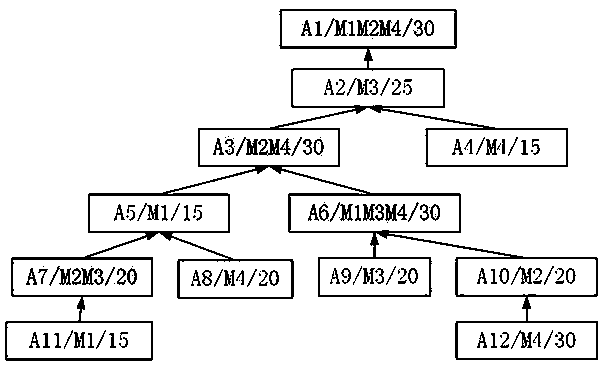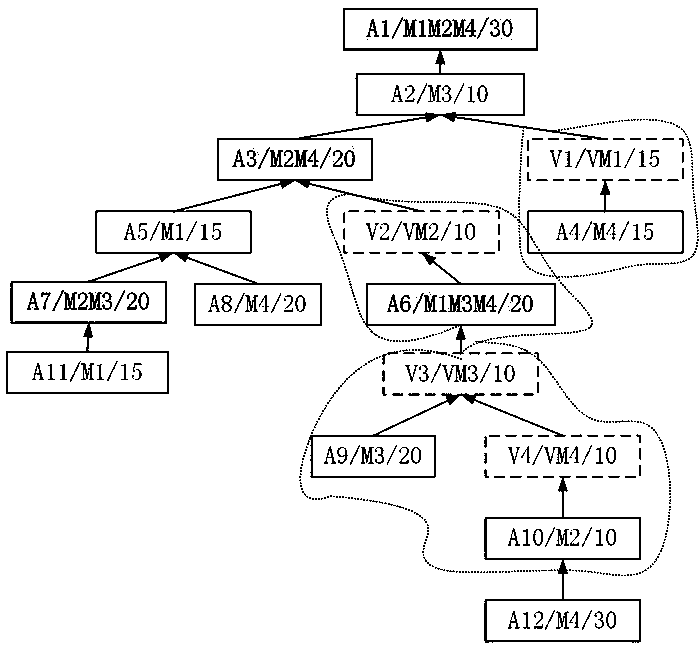Comprehensive scheduling method with non-close connection of multiple equipment processes
A scheduling method and multi-device technology, applied in data processing applications, instruments, computing, etc., can solve the problem of high production costs, achieve the effect of solving equipment resource occupation, solving equipment resource occupation problems, and reducing algorithm time complexity
- Summary
- Abstract
- Description
- Claims
- Application Information
AI Technical Summary
Problems solved by technology
Method used
Image
Examples
Embodiment 1
[0042] A comprehensive scheduling method with non-compact multi-equipment procedures, the method includes the following steps:
[0043] A comprehensive scheduling method with non-closely connected multi-equipment processes is characterized by adopting a multi-equipment optimization model with delay constraints. Firstly, adopt the strategy of transforming the delay constraint into the delayed process, so that the non-closely connected process problem is transformed into a general scheduling problem, and the delayed process and the immediate preceding process are transformed into a closely connected process group, so that the delayed process can start processing as soon as possible; then, using The device-driven strategy determines the processing procedure; secondly, according to the priority scheduling strategy of multi-device procedures, the problem of device resource occupation is effectively solved, and the related idle waiting time and idle device search time are reduced; fi...
Embodiment 2
[0045] Considering that there is a comprehensive scheduling method that does not closely connect multiple equipment processes, the specific implementation steps of the scheduling method are as follows:
[0046] Step 1: Construct the processing technology tree according to the input product processing information, convert the delay constraints between processes into delayed processes, and use the conversion strategy from non-closely connected processes to closely connected process groups to convert the processing technology tree into a product processing technology with non-closely connected process groups Tree;
[0047] Step 2: Perform breadth-first traversal (BFS) on the processing tree, set priorities for all processes by layer, and establish a schedulable process set;
[0048] Step 3: At the initial moment, all devices are idle, and the device driver creates an idle device set at all times.
[0049] Step 4: The device driver judges the number of idle devices in the set of ...
Embodiment 3
[0062] The product processing process tree is to expand the product process to the processing process tree. Each node in the process tree represents a process. The information in the node includes the process name, processing equipment, and processing time; the relationship between the root node and the leaf in the process tree represents the process. In terms of technology, the constraint relationship is tight before and after; the multi-equipment process satisfies the constraint relationship of simultaneous start and simultaneous end on related equipment.
[0063] Considering that there is a comprehensive scheduling method for non-closely connected multi-equipment processes, it is characterized in that: the transformation strategy from non-closely connected processes to closely connected process groups is based on the relationship between the processes with delay constraints, and the delay constraints are converted into delayed Process, that is, virtualize the delay time betw...
PUM
 Login to View More
Login to View More Abstract
Description
Claims
Application Information
 Login to View More
Login to View More - R&D
- Intellectual Property
- Life Sciences
- Materials
- Tech Scout
- Unparalleled Data Quality
- Higher Quality Content
- 60% Fewer Hallucinations
Browse by: Latest US Patents, China's latest patents, Technical Efficacy Thesaurus, Application Domain, Technology Topic, Popular Technical Reports.
© 2025 PatSnap. All rights reserved.Legal|Privacy policy|Modern Slavery Act Transparency Statement|Sitemap|About US| Contact US: help@patsnap.com



